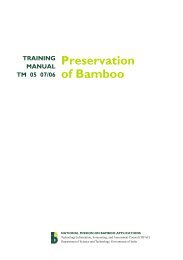ASTM
Create successful ePaper yourself
Turn your PDF publications into a flip-book with our unique Google optimized e-Paper software.
1898<br />
1902<br />
1902<br />
1902<br />
1903<br />
1903<br />
A-1 on<br />
Steel,<br />
Stainless<br />
Steel, and<br />
Related Alloys<br />
C-1 on<br />
Cement<br />
B-2 on<br />
Nonferrous<br />
Metals and<br />
Alloys<br />
D-1 on<br />
Paint and<br />
Related<br />
Coatings,<br />
Materials, and<br />
Applications<br />
A-6 on<br />
Magnetic<br />
Properties<br />
D-4 on<br />
Road and<br />
Paving<br />
Materials<br />
30 “A Broader View”<br />
A<br />
from Yale University in 1874, and who later became<br />
the driving force behind <strong>ASTM</strong>. Dudley organized the<br />
railroad’s new chemistry department, where he investigated<br />
the technical properties of oil, paint, steel, and<br />
other materials the Pennsylvania Railroad bought in<br />
large quantities. Based on his research, Dudley issued<br />
standard material specifications for the company’s<br />
suppliers.<br />
Dudley soon realized that he had taken on a<br />
formidable task. In 1878, he published his first major<br />
report, “The Chemical Composition and Physical<br />
Properties of Steel Rails,” in which he analyzed the<br />
durability of different types of steel rails. It concluded<br />
that mild steel produced a longer-lasting rail than<br />
hard steel, and Dudley recommended an improved<br />
formula for mild steel for rails to be used by the<br />
Pennsylvania. His<br />
report raised a<br />
firestorm among<br />
steel masters,<br />
who disputed its<br />
findings. The<br />
application of<br />
Dudley’s new<br />
formula, they<br />
charged, produced<br />
unnecessary<br />
expenses that<br />
increased production<br />
costs. Steel producers, determined to keep full<br />
control over output and quality control, viewed<br />
standard specifications issued by their customers as<br />
unacceptable meddling. Dudley later reported that<br />
steel companies often told the railroads that “if they<br />
did not take the rails offered [by the manufacturers],<br />
they would not get any.”<br />
A. The struggles between early steel makers and corporate consumers<br />
over the quality of steel led Charles Dudley to champion the need for<br />
standard material specifications. Photo credit: American Iron and Steel<br />
Institute; Historical File<br />
The disappointing response to his first report<br />
reinforced Dudley’s resolve to initiate a constructive<br />
dialogue between suppliers and their customers. Each<br />
party had much to learn from the other. Steel makers<br />
knew more about practical production issues and the<br />
industry’s cost structure than their customers, while<br />
railroads, locomotive builders, and other<br />
users of steel products had better knowledge of a<br />
material’s long-term performance, knowledge that<br />
could help manufacturers improve the quality of rails,<br />
plates, and beams. Dudley concluded that “a good<br />
specification needs both the knowledge of<br />
the product’s behavior during manufacture and<br />
knowledge of those who know its behavior while<br />
in service.”<br />
The introduction of more powerful locomotives,<br />
heavier rolling stock, and longer trains gave buyers<br />
an additional incentive to work more closely with<br />
their suppliers. Statistics compiled by railroad engineers<br />
indicated that the average wheel load of cars<br />
increased 75%, and traffic volume rose more than<br />
300% during the late 19th century. Rail manufacturers<br />
needed this kind of data to supply steel that<br />
conformed to higher performance standards. But<br />
the lack of cooperation between producers and users<br />
of steel rails was an enormous detriment to such<br />
improvements.<br />
THE BIRTH OF<br />
CONSENSUS<br />
Dudley’s efforts to find<br />
a solution to these<br />
seemingly intractable<br />
problems facilitated the<br />
formation of <strong>ASTM</strong>,<br />
which was committed to<br />
building a consensus on<br />
standards for industrial<br />
materials. The founding<br />
of the organization in 1898 was preceded by several<br />
key initiatives that laid the groundwork.<br />
B<br />
B. Meeting of the Section on Alloy Steel Forgings of Committee A-1




